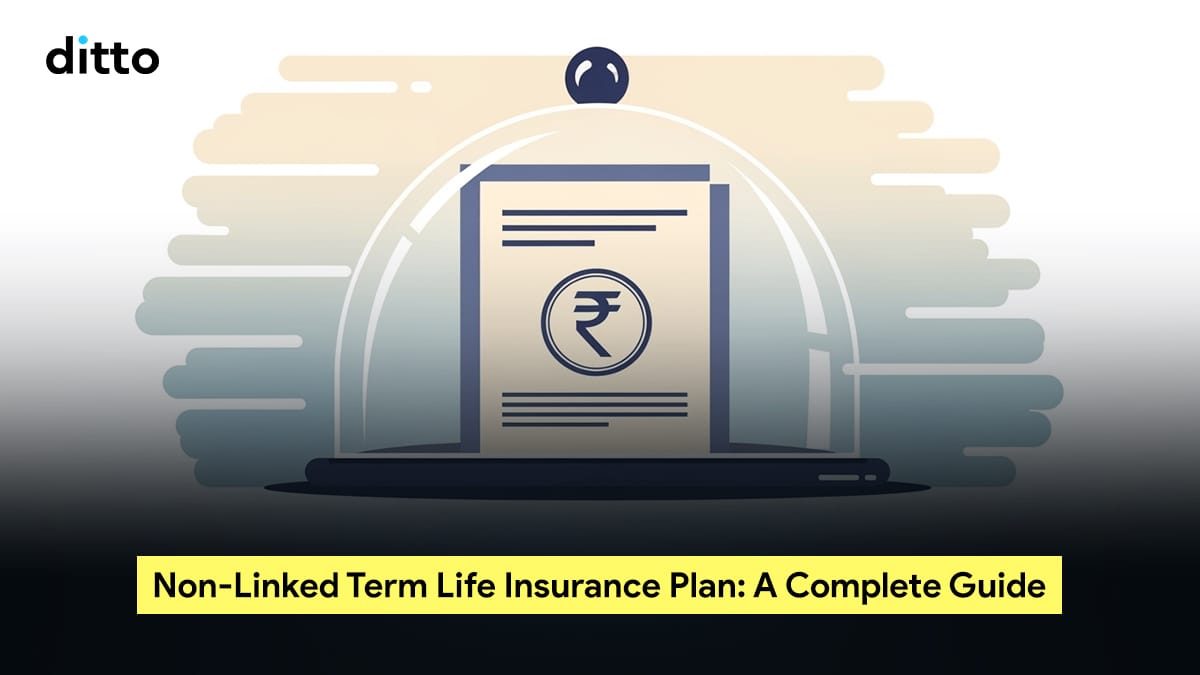| What is the Non-linked Term Life Insurance Plan? A Non-Linked Term Life Insurance Plan is a type of pure term insurance policy that offers financial protection without any link to market performance or investment returns. Unlike Unit Linked Insurance Plans (ULIPs), which invest premiums in market-linked funds, non-linked term plans do not invest in the capital markets. Instead, these plans provide a fixed death benefit to the nominee if the insured dies during the policy term, without any bonuses or profit participation. This structure makes them low-risk and affordable, with fixed premiums throughout the policy tenure. |
For most Indians, term insurance is the simplest way to secure their family’s future, yet many struggle to understand the difference between linked and non-linked policies. The confusion often leads to poor decisions like paying higher premiums for features they may never use.
At Ditto, our advisors speak to thousands of working professionals every month about these choices, and we’ve seen firsthand how often non-linked term plans are overlooked simply because people don’t know how they work.
For this guide, we’ve analyzed IRDAI’s master circular on life insurance products, and other actual products live in the market to walk you through how non-linked term life insurance works and compares with other plans.
Better yet, consult Ditto’s certified advisors by booking a call for personalized guidance if you’re still confused or overwhelmed by the options
What Does the Non-linked Term Life Insurance Plan Cover?
A Non-Linked, Non-Participating, Individual, Pure Risk Premium Life Insurance Plan provides financial security without any connection to market performance. These plans offer guaranteed benefits with fixed premiums and payouts. They are also called non-participating because they do not share in the insurer's profits, meaning no bonuses or dividends are given.
A non-linked term life insurance plan provides coverage solely against premature death, offering a lump sum to beneficiaries. Since there's no investment component, premiums tend to be lower in this context. Moreover, the payout amount is predefined and guaranteed on claim, subject to exclusions.
| Did You Know? The Insurance Regulatory and Development Authority of India (IRDAI) provides clear terminology to classify insurance products. Understanding these terms helps buyers comprehend the nature and benefits of insurance plans. 1)Linked Vs. Unlinked Insurance Plans: Linked plans are tied to market investments, while unlinked plans offer fixed benefits. 2)Par vs. Non-par Insurance Plans: Par plans share profits via bonuses, whereas non-par plans provide guaranteed returns only. 3) Savings vs. Pure Risk Insurance Plans: Savings plans build wealth alongside protection, while pure risk plans focus only on life cover. While term plans are classified as pure risk, those with return of premium features are classified as savings products since they return the premiums at maturity. Remember: a)Term plans are always non-linked, non-participating b) Savings/endowment can be either non-linked and may be structured as participating or non-participating c)ULIPs are always linked and non-participating |
How Does Non-Linked Term Insurance Work?
A non-linked term life insurance plan follows a simple yet effective structure ideal for individuals seeking stable, low-cost life cover without investment risks or complexities.
Here’s how it works:
- The policyholder chooses the sum assured, policy term, and premium payment frequency before purchasing the plan.
- The premium paid covers only the risk of death; no investment component is involved.
- If the insured dies within the policy term, the nominee receives the pre-agreed sum assured as a death benefit.
- Some variants of non-linked term plans offer a "return of premium," where if the insured survives the term, the total premiums paid are refunded.
- Since it does not participate in profits or market performance, the premiums remain fixed and affordable throughout the tenure, and no bonuses are added.
Quick Note: As per IRDAI regulations, if you surrender your non-linked life insurance or pension policy before it matures, you’ll receive a portion of the premiums you’ve paid. This specifically varies by insurer and policy type, so always check the surrender value before signing.
What Factors Should I Consider When Selecting a Non-linked Term Insurance Plan?
When selecting a Non-Linked Term Insurance Plan, several key factors should be considered to ensure it meets your financial protection needs effectively.
- Sum Assured (Coverage Amount): Choose a coverage amount that adequately safeguards your family's financial needs in case of your untimely demise. This should consider liabilities like loans, living expenses, children’s education, and future financial goals. If you also want to know your exact coverage amount, try Ditto’s calculator to get a better idea of your requirements.
- Policy Term: Select a policy tenure that aligns with your financial obligations and risk exposure period. At Ditto, we generally advise getting coverage up to 65 years because most dependents become financially stable by that time.
- Premium Payment Tenure and Frequency: Terms may include single, limited, or regular premium options. Premium payment frequency (monthly, quarterly, half-yearly, annually) should also be affordable within your budget. Always keep in mind that annual payments are cheaper than frequent monthly or quarterly payments.
- Standard Benefits: Non-linked term plans primarily provide a fixed death benefit (sum assured) without any investment or profit participation. Some plans also offer inbuilt features like terminal illness cover, instant payout on claim intimation, premium break option, health management services, and grief counselling for nominees.
- Optional Riders: Riders enhance base coverage and protect against specific risks like disability or critical illness. We generally recommend the waiver of premium rider (in case of disabilities or illness) and the critical illness rider for those with serious health conditions.
- Claim Settlement Ratio and Insurer Reputation: Higher claim settlement ratios (<90%), strong solvency, lower complaints (<15 per 10,000 claims), and strong insurer credibility (above ₹1,000 crore annual business) assure that claims will be processed smoothly.
- Premium Affordability: Since non-linked plans don’t have investment components, premiums are generally affordable, but it’s essential to check premium amounts in relation to the coverage.
Classification of Popular Life Insurance Products as Per IRDAI Nomenclature
| Product Category | Linked / Non-Linked | Participating (Par) / Non-Participating (Non-Par) | Product Type (Pure-Risk / Savings) | Typical Examples / Remarks |
| Term Insurance (Pure Protection Plans) | Non-Linked | Non-Participating | Pure-Risk | Pays death benefit only; no market link, no bonus. |
| Term with Return of Premium (ROP) | Non-Linked | Non-Participating | Savings (Hybrid) | Treated as a non-linked, non-par savings product because it has a survival/maturity payout. |
| Endowment Plans (Traditional with-profits) | Non-Linked | Participating | Savings | Offers death + maturity benefit plus bonuses; classic “with-profits” policies. |
| Non-Par Guaranteed Plans (Assured Returns / Income) | Non-Linked | Non-Participating | Savings | Offers fixed benefits (lump sum or income) known upfront; no bonus or market link. |
| Money-Back Plans | Non-Linked | Participating or Non-Participating | Savings | Periodic survival payouts during the policy term; may or may not include bonuses. |
| Whole Life Plans | Non-Linked | Participating or Non-Participating | Savings / Protection mix | Lifetime cover; often with bonuses (Par) or guaranteed additions (Non-Par). |
| ULIPs (Unit Linked Insurance Plans) | Linked | Always Non-Participating | Savings / Investment | Market-linked returns; fund switches, NAV-based, 5-year lock-in. |
| Index-Linked Insurance Plans (ILIPs) | Linked (Index-linked) | Non-Participating | Savings / Investment | Benefits linked to equity or debt indices (e.g., NIFTY, G-Sec yields). |
| Annuities (Immediate / Deferred) | Non-Linked | Non-Participating | Savings (Income stream) | Provides regular guaranteed income for life or a fixed period. |
| Pension / Deferred Annuity (Accumulation + Income) | Linked | Non-Participating | Savings | The accumulation phase followed by annuity; can be linked. |
| Micro-Insurance Products | Non-Linked | Non-Participating | Pure-Risk / Savings (as applicable) | Simplified versions for low-income groups; regulated separately but follow the same Par/Non-Par logic. |
| Riders (Add-ons) | Same as Base Plan | Same as Base Plan | Pure-Risk | Add protection for accident, disability, illness, etc.; premiums cannot exceed 100% of base SA. |
Premiums for Non-linked Term Life Insurance Plans That Ditto Recommends
| Before we discuss the list, here’s how we decide what plans to feature. At Ditto, every term plan goes through our six-point evaluation framework. It doesn’t mean these are the only good plans, but that they stand out after being scored across all six pillars. You can learn more about how we evaluate health insurance plans here. |
Let’s calculate the premiums for a 30-year-old male (non-smoker and non-diabetic) seeking a cover of ₹1 crore till 65 years.
| Plan | Premiums |
| HDFC LIFE Click2Protect Supreme | ₹14,241 |
| ICICI Prudential IProtect Smart Plus | ₹12,154 |
| AMLI Smart Term Plan Plus | ₹11,937 |
| BALIC E-Touch II | ₹12,117 |
Ditto’s Take on Non-linked Term Life Insurance Plans
Non-linked term plans are the best protection choice available in the market on a cover per rupee basis. Any other alternative life insurance that combines insurance and investment needs to be carefully studied. These often provide low insurance coverage, and the returns are subpar compared to counterparts like mutual funds/FDS/NPS.
Insurance should never be sold as an investment. Our advisors recommend:
- If you want wealth creation, invest in mutual funds or index funds because they’re transparent, liquid, and built for returns.
- If you want protection, buy a non-linked term plan, which is clean, affordable, and designed for security.
Bottom Line: A non-linked term plan delivers maximum life at affordable pricing because there’s no savings or investment component involved. The premiums are often 10–15 times cheaper than endowment or guaranteed-income plans that promise returns but compromise on coverage.
For the same ₹15,000 a year, you could either:
- Get ₹1 crore cover via a non-linked term plan, or
- Just ₹3–5 lakh in a “savings-type” plan.
At Ditto, we prefer protection first, investment later, because your family can’t live off a maturity value if you’re not around.
Why Choose Ditto for Term Insurance?
At Ditto, we’ve assisted over 7,00,000 customers with choosing the right insurance policy. Why customers like Arun love us:

✅No-Spam & No Salesmen
✅Rated 4.9/5 on Google Reviews by 5,000+ happy customers
✅Backed by Zerodha
✅100% Free Consultation
You can book a FREE consultation. Slots are running out, so make sure you book a call now!
Final Thoughts on Non-linked Term Life Insurance Plans
You must always choose your life insurance investment options based on your financial objectives, risk tolerance, and budget because not all plans are designed the same. Non-linked insurance plans are a better choice if you want a stable return without market risk. Conversely, linked insurance plans are recommended if you are comfortable with market-linked fluctuations and want to take advantage of the high growth potential.
Since both types of life insurance plans have their pros and cons, understand the policy clearly before investing. Learn how linked and non-linked plans work before making a decision.
FAQs
Can I add riders to enhance the coverage in such plans?
Yes, you can add riders to enhance the coverage of Non-Linked Term Insurance Plans. Riders like the accidental death benefit, waiver of premium, and critical illness add-on can help customize your plan to meet specific needs and risks by offering more comprehensive financial security.
Are premiums paid for non-linked term insurance plans eligible for tax benefits?
Yes, premiums paid towards non-linked plans are eligible for tax deductions under Section 80C of the Income Tax Act (Old regime), up to ₹1.5 lakh per financial year. Maturity proceeds and death benefits are generally exempt from tax under Section 10(10D), provided certain conditions are met.
Can dividends or bonuses from non-linked participating plans be guaranteed?
No, bonuses and dividends declared by insurers in participating plans are not guaranteed; they depend on the profitability of the insurance company in a given year. However, the sum assured and other guaranteed benefits remain fixed and payable irrespective of bonus declarations.
How flexible are these plans in terms of premium payments and policy modifications?
Insurance plans generally offer flexibility in premium payment modes and tenures, allowing policyholders to select annual, semi-annual, quarterly, or monthly premium payments based on convenience. Many insurers also provide options for policy loans against surrender value and partial withdrawals, providing liquidity when needed.
Last updated on:








